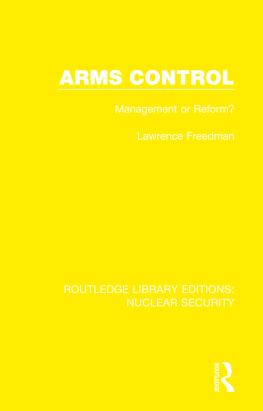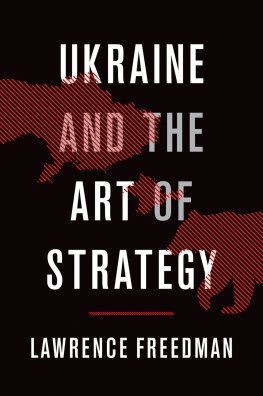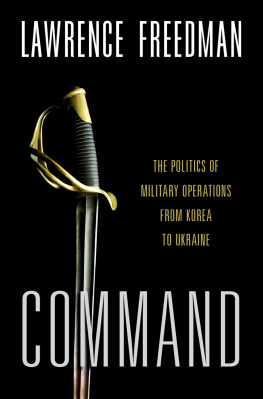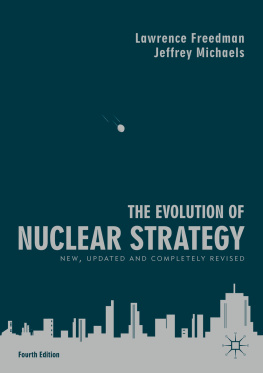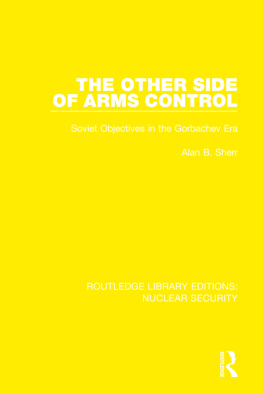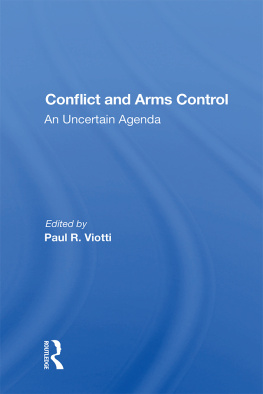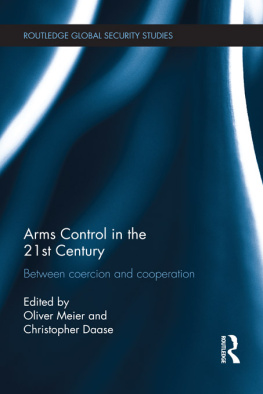ROUTLEDGE LIBRARY EDITIONS: NUCLEAR SECURITY
Volume 26
ARMS CONTROL
First published in 1986 by Routledge & Kegan Paul Ltd
This edition first published in 2021
by Routledge
2 Park Square, Milton Park, Abingdon, Oxon OX14 4RN
and by Routledge
52 Vanderbilt Avenue, New York, NY 10017
Routledge is an imprint of the Taylor & Francis Group, an informa business
1986 Royal Institute of International Affairs
All rights reserved. No part of this book may be reprinted or reproduced or utilised in any form or by any electronic, mechanical, or other means, now known or hereafter invented, including photocopying and recording, or in any information storage or retrieval system, without permission in writing from the publishers.
Trademark notice: Product or corporate names may be trademarks or registered trademarks, and are used only for identification and explanation without intent to infringe.
British Library Cataloguing in Publication Data
A catalogue record for this book is available from the British Library
ISBN: 978-0-367-50682-7 (Set)
ISBN: 978-1-00-309763-1 (Set) (ebk)
ISBN: 978-0-367-55075-2 (Volume 26) (hbk)
ISBN: 978-1-00-309190-5 (Volume 26) (ebk)
Publishers Note
The publisher has gone to great lengths to ensure the quality of this reprint but points out that some imperfections in the original copies may be apparent.
Disclaimer
The publisher has made every effort to trace copyright holders and would welcome correspondence from those they have been unable to trace.
CHATHAM HOUSE PAPERS 31
ARMS CONTROL
MANAGEMENT OR REFORM?
Lawrence Freedman
The Royal Institute of International Affairs is an unofficial body which promotes the scientific study of international questions and does not express opinions of its own. The opinions expressed in this paper are the responsibility of the author.
First published 1986
by Routledge & Kegan Paul Ltd
11 New Fetter Lane, London EC4P 4EE
29 West 35th Street, New York, NY 10001, USA
Set by Hope Services, Abingdon and printed in Great Britain by
Billing and Son Ltd, Worcester
Royal Institute of International Affairs 1986
No part of this book may be reproduced in any form without permission from the publisher, except for the quotation of brief passages in criticism.
Library of Congress Cataloging-in-Publication Data
Freedman, Lawrence.
Arms control.
(Chatham House papers: 31)
The Royal Institute of International Affairs.
1. Nuclear arms controlUnited States. 2. Nuclear
arms controlSoviet Union. 3. Negotiation.
4. Security, International. 5. EuropeDefenses.
I. Royal Institute of International Affairs.
II. Title. III. Series.
JX1974.7.F725 1986 327.174 86-15587
ISBN 0-7102-0893-6
| ABM | Anti-Ballistic Missile |
| ALCM | Air-Launched Cruise Missile |
| CBMs | Confidence-Building Measures |
| CDE | Conference on Disarmament in Europe |
| CSCE | Conference on Security and Cooperation in Europe |
| GLCM | Ground-Launched Cruise Missile |
| ICBM | Intercontinental Ballistic Missile |
| INF | Intermediate Nuclear Forces |
| IRBM | Intermediate-Range Ballistic Missile |
| MAD | Mutual Assured Destruction |
| MBFR | Mutual and Balanced Force Reductions |
| MIRV | Multiple Independently Targetable Re-entry Vehicle |
| MX | Missile Experimental |
| NATO | North Atlantic Treaty Organization |
| NNA | Neutral and Non-Aligned (countries) |
| SALT | Strategic Arms Limitation Talks |
| SDI | Strategic Defence Initiative |
| SLBM | Submarine-Launched Ballistic Missile |
| SSBN | Ballistic-Missile-Carrying Nuclear Submarine |
| START | Strategic Arms Reduction Talks |
This paper began as a revision of a Chatham House Paper published in 1981 on Arms Control in Europe. The revision turned out to be more substantial than I originally anticipated, so that this, in most respects, is a new paper. The experience of the intervening years suggested many areas in which the argument needed sharpening. It has also been an eventful, if not especially productive, few years for arms control, which encouraged me to concentrate on the most prominent of recent developments and trends.
One of the problems with arms control is that the detail can soon become overwhelming. Unfortunately much of the detail is also important. I have dealt with this problem by relegating background descriptions of the negotiations to a series of appendices, which I hope will be found useful for reference purposes.
I am very grateful to a study group, organized by the Royal Institute of International Affairs, whose discussion of an earlier draft led to considerable modification and amendment, and also to those students who have taken my arms control course at Kings College and have helped me more than I have let them realize! It has been a special pleasure to work again with two friends and former colleagues from Chatham House Joan Pearce and Pauline Wickham whose combined editorial talents are quite formidable. Thanks are also due to Nigel Pearce for his work on the manuscript.
June 1986
L.F.
INTRODUCTION
In the aftermath of the November 1985 summit between President Ronald Reagan and General-Secretary Mikhail Gorbachev, arms control was widely seen to be back on track. The lack of progress in building on the spirit of that summit during the first few months of 1986 dampened enthusiasm, but it is still generally felt that the major powers are embarked on a serious negotiating exercise that could well produce results over the next few years.
Much of this paper is taken up with examining this exercise and the issues being addressed. It draws attention to the many problems still to be overcome if agreements are to be reached, as well as to the areas of possible compromise that have already become apparent. It also offers a critical analysis of the arms control process. The line of argument developed here is not that of the hawk who complains that arms control has served only as an instrument of Soviet policy by lulling us into a false sense of security and so providing an excuse for avoiding military preparedness. Nor is it that of the dove who points contemptuously to collections of permissive ceilings and marginal constraints which barely inconvenience military planners and are merely superpower confidence tricks reflecting the lack of political will to stop the arms race.
Rather, the analysis highlights the confusion surrounding the objectives of arms control, and the effects of this confusion on the practice. The objectives are often taken for granted, on the assumption that it is the degree of mistrust separating the two sides that determines the extent to which the objectives can be met. Closer examination, however, soon reveals that arms control is pursued for many different reasons, which are by no means always in concert. There is also a tension between two alternative approaches, which do not so much separate East from West as the reformers from the managers hence the title of this essay.

